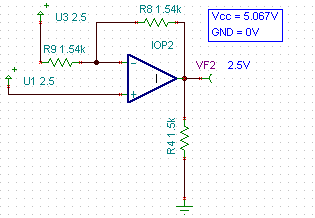After years of working with op amps I'm stumped.
This should be op amps 101. What scares me is that I'm gonna look real stupid for missing something simple.
I tried both a OPA376 and OPA340 in the circuit below.

This is the sequence of events and measurements.
1. Turn on Power
2. Measure output = 2.5V
3. Wait 10 seconds, measure output = 2.5V
4. Wait 10 seconds, measure output = 2.5V
5. Wait 10 seconds, measure output = 2.75V
6. Wait 10 seconds, measure output = 3.46V
7. Wait 10 seconds, measure output = 3.78V
8. Wait 10 seconds, measure output = 4.34V
9. Wait 10 seconds, measure output = 4.83V
10. Wait 10 seconds, measure output = 4.98V
11. Wait 10 seconds, measure output = 4.98V
12. Turn off power, wait 30 seconds
13. GoTo step 2
IN+, IN-, Vcc remain constant throughout test.
The output keeps drifting to upper rail.
What is a list of things that could possibly cause this?

